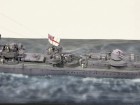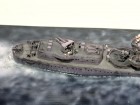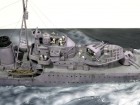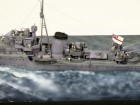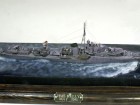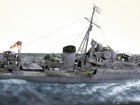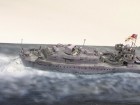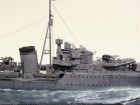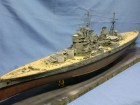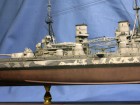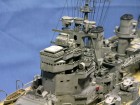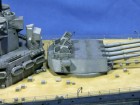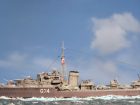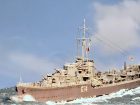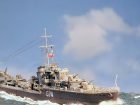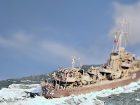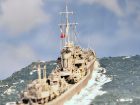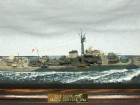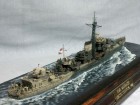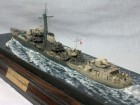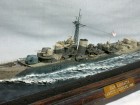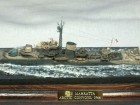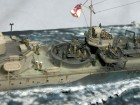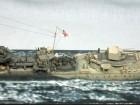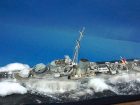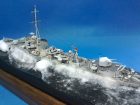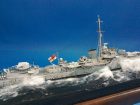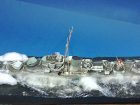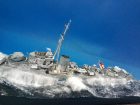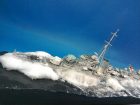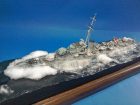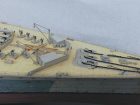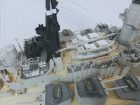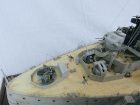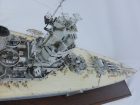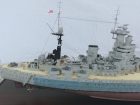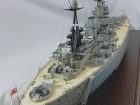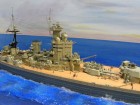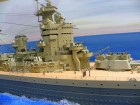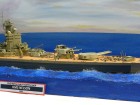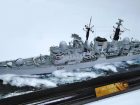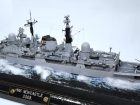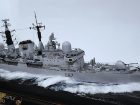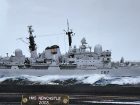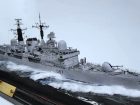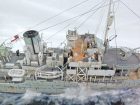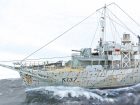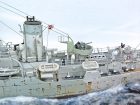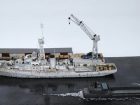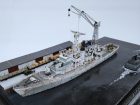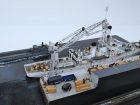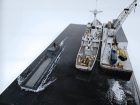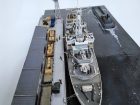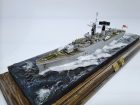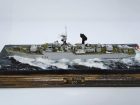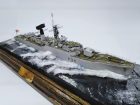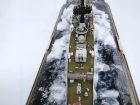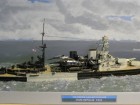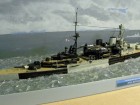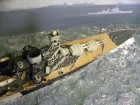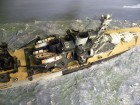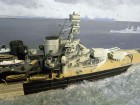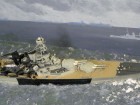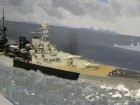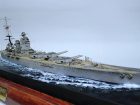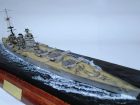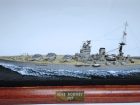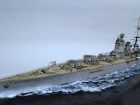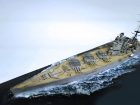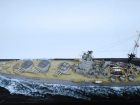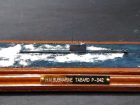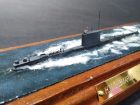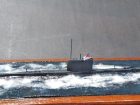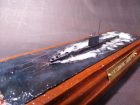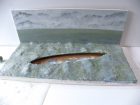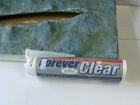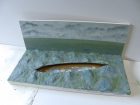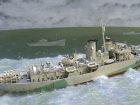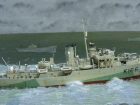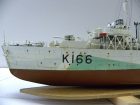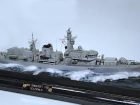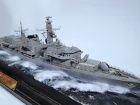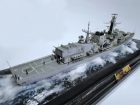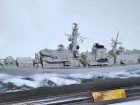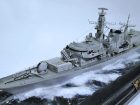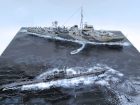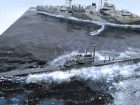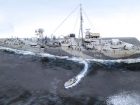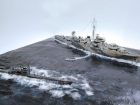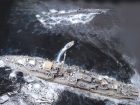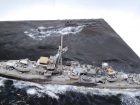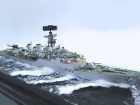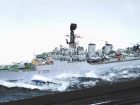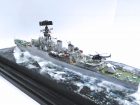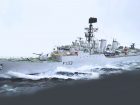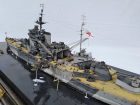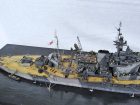The KGV is how the vessel appeared in December 1940 before she when in for a refit and re-painting in early 1941. Her colour scheme then was overall dark grey with wooden decks left unpainted and steel decks dark grey.
Ian R.
Unfortunately, I discovered the hull had a slight sag so had to place her in quite a lively sea with a swell (otherwise her stern would appear to be rising 1 mm). During my first photo shoot after a few snaps I snagged my base scenery which wiped out the fore mast radar, radio aerials and after 4″ barrels, such is life with these fragile 1:700 ships. Re-rigged aerials and re-purchased brass 4″ barrels were necessary for the second photo shoot which was mercifully not error prone.
With war approaching the RN stepped down from the big Tribal Class to the somewhat lessor armed J, K, and L class destroyers. The pre-war view of the major threat coming from other destroyers and submarines was starting to look unbalanced as the power of the German and Italian air forces was appreciated. The twin 4″ MkXVI mount became the AA unit of choice and Legion was armed with these rather than the anti-ship 4.7″ guns. The Legion famously came to the aid of the torpedoed Ark Royal and took off many of her crew before she sank.
After fighting with distinction in the Mediterranean, she was severely damaged by Air attack and put into Malta where she was sunk by bombing on 26th March 1942.
Regards
Andrew J.
Mahratta was an M-class destroyer of the Royal Navy which served during World War II. She began as Marksman, was damaged while under construction, and dismantled to be rebuilt on a new slipway. She served on the Arctic Convoys until she was struck by a torpedo from U-990, she sank with the loss of 219 men. Despite other Navy vessels coming to her aid only 2 of her crew survived. The model shows the ship how she would have appeared at this time.
Ian R.
Here’s my model of the Tamiya 1:350th scale Japanese heavy cruiser Mogami.
The base kit is Tamiya’s excellent kit no78021 Japanese aircraft carrying cruiser Mogami. At the time of build there were no dedicated detailing sets available so I used:
- Tamiya degaussing cables set12630 (enough in this set to cover two cruisers)
- White Ensign Models PE 35100 Takao Class Cruiser detailing set and PE 35018 Imperial Japanese Navy Doors & Hatches set
- The figures seen on the model are Fujima part no. 111506 1:350th scale Figure set (Imperial Japanese Navy Seamen) they produce two sets this one in static poses and the other in action poses (set 111650). These are fully rounded injection moulded figurines that can be primed and individually painted before adding to model.
I wanted to show the vessel at sea launching one of her float-spotter planes with a large number of crew figures on deck. Ian R.
The model is from Flyhawk and in 1:700 scale.
The HMS Naiad belonged to the class of Dido light cruisers. Sixteen ships were built of the class and these were based on the Arethusa class light cruiser. The armament was to consist of five 5.25 in (133 mm) guns in twin turrets. These turrets were also used as secondary armament in the King George V battleships. Due to supply shortages, however, not all ships were equipped with them. The Naiad was laid on keel on 26 August 1937.
The launch took place as the first ship in the class on February 3, 1939. The commissioning followed on 24 July 1940. The Naiad belonged to the group with five 5.25 in gun turrets. The other armament consisted of two quadruple 40 mm pom-poms guns, two 0.5 in quadruple MGs, one 47mm cannon and two 21 in triple torpedo tubes. Initially, the Naiad was used in the Home Fleet. In January 1941, the Naiad was used in the northern sea and there spotted for a short time the German battleships Scharnhorst and Gneisenau. In May 1941, however, she was transferred to the Force H in the Mediterranean and became the flagship of the 15th cruiser squadron. There she took part in the supply trips to the island of Malta. On March 11, 1942, she was discovered and sunk by the German submarine U-565 south of Crete. In the process, 77 men lost their lives to the crew.
The kit comes from the company Flyhawk and is thus one of the best plastic model ships available on the market. The construction also progressed quickly and does not cause any problems. But you should always have the construction manual in view and follow it. It was also a bit strange that the superstructure parts had a lot of free adjustment. This makes it necessary to make sure that they are correctly aligned when later gluing the superstructure parts. With newer kits like the Prince of Wales this has been better solved by Flyhawk. Otherwise, the kit includes everything necessary to build a great model. I used additionally turned brass barrels for the 5.25 in guns from Flyhawk. Likewise, I used Bigboyblue replacement for the reels and etched parts from Flyhawk for the light AA guns.
I have painted the model with Vallejo colors and but not with the colour of the instructions, but in the more usual 507A, 507B and 507C camouflage scheme. The wooden deck was also painted with Vallejo colors. The ageing took place with oil paints. The water design was done as usual with the Water Effects from Vallejo. For the waves, I added cotton into the water surface again.
Greetings Christian H.
This is HMS Pink a Flower Class Corvette circa 1942-43 Western Atlantic – it’s a partly scratch-built conversation from the Revell 1:144th scale kit of HMCS Snowberry.
Besides the scratch-built sections I used the Eduard & Starling Models photo etch and L’ARSENAL resin sets, the latter replaces the weapons with cast resin and photo etch replacements.
This particular vessel is the least photographed ship of the Flower’s with only four photographs known, of those only two were suitable for the period I’ve depicted.
Ian R.
Added: Great Little Ships (GLS) PE set and white metal for weapons & bridge
Referenced: HMS Poppy K213 (circa 1941)
Check this out: http://www.cbrnp.com/RNP/Flower/ARTICLES/Poppy/index.htm
HMS Poppy is a Flower Class Corvette commonly built round the UK during WWII. This particular vessel based on a whaler design was built at Alexander Hall’s shipyard in Aberdeen, Scotland during 1940/1941 (I have mistakenly referred to Hall Russell, a much later yard takeover before now).
Launched in ‘41 she took part in the ill-fated convoy PQ17, a story in itself. My connection with this ship was firstly the location of her construction, Aberdeen, my ‘home’ port. At that time my grandfather worked on her at the yards, a side connection is the name ‘Poppy’, all ships of this class were named after popular flowers, in this case it is the ‘by’ name of my spouse, so the choice of candidates shrunk to a crowd of one!! Most corvettes had art on their main gun turret, ‘Poppy’s’ was Popeye and the tune played when she left and arrived at harbour was “Popeye The Sailor Man”.
The kit itself OOB is impressive, but add some of the exquisite details available from GLS, and it becomes astounding. I just couldn’t justify the additional ‘deck set’ or ‘funnel set’, the kit being pretty good as it was, but the bridge and weapons set(s) were enough to make it look ‘right’.
This was a very enjoyable build, though the size of the project meant it took many months to complete. All being said, I’d do it again and recommend anyone interested in maritime subjects to give a ‘Flower’ a chance…!!
Mick Stephen (2011)
Rather than the usual scene of ship steaming at sea, I thought I’d build a scene of it in port.
What you see with exception of quayside, rolling stock, crates and vehicles are scratchbuilt using plastic card and evergreen shaped plastic strip for the buildings and lighter steaming past. The crane is a spare photo etch mast, the cab is a 5” turret from a Fletcher Class destroyer and jib is a jib from a KGV photo etch set plus bits from spares box.
The whole diorama is only about 8 to 9 inches long (it looks bigger!).
Ian R.
The Tamiya kit is Rodney when she first entered service not WW2 as it says in instructions, to build ship in that period you’ll have to make changes to her superstructure, weapons etc.
Ian R.
The client (one of her crew) wanted her building after the vessel was modernised and hull extended in the 1950’s when he first served on her. The conversation meant altering the bow, extending the hull aft of the conning tower, completely new conning tower (sail) and removal of external torpedo tubes.
Ian R.
Scratchbuilt project…
The bulk of the construction was made from a commercial resin compound called Prolab 65 or Modelboard, it’s a resin based material that can be easily cut and carved to shape. I use it for the basic hull forms on my scratchbuild ship models.
Anyway I digress, after carving the basic hull and superstructure the model was detailed using various shaped pieces of plastic card strip from Evergreen. The model was primed before the actual colours were applied, I won’t bore you with the details but I painted and weathered it in my usual fashion before it was applied to its base and the seascape formed around it (see SMNs Techniques Bank on how to do this). The basis of this is made from interior Polyfiller with the tips of the waves crests made from pieces of PVA soaked cotton wool stretched very thin and applied onto the dry plaster using PVA. Once dry the seascape was spray painted using my airbrush. The figures came from some figures I found on a railway modelling site. These were primed and painted in suitable colours for RN crew.
Ian R.
Ian Ruscoe’s Top Tip
When using superglue NEVER apply the glue directly from the tube to the part always apply a pool of the glue to a piece of scrap card and then holding the etch in tweezers carefully dab the piece through the top of the glue, with any excess dabbed off onto the card before you then apply it to the model. When applying ship’s railings it’s best to wet the thumb and index finger of the other hand you’re not using with saliva so that the glue won’t attach you to the part when you use them to guide the railing into position. Superglue won’t stick to saliva.
This is Revell’s large 1:72nd scale Flower class corvette kit built using extensive detailing sets that replace over ¾ of the kit parts. The model is roughly 3 feet long and 5 inches at its widest.
Not the best kit but certainly one of the biggest commercially available kits of this class of vessel. Most of the deck fittings and all the weapons, Bridge and other structures were replaced with replacement update parts.
There are no good points about this kit as the detail on the parts is very soft and over scale, the parts are covered in flash and large ejection marks and in the case of the larger parts even warped.
I used the David J. Parkins Great Little Ships updates on this and although the detail is good they take an age to assemble and in some cases I substituted some of the parts with scratchbuilt replacements as they were too thin. With all the brass (the entire deck area is replaced with brass sheets) and white metal parts the model has some considerable weight to it and will require a sturdy base. One other thing most of the Great Little Ship assemblies are best soldered, so brush up on your soldering skills.
It’s a shame I have utter contempt for this kit as in this scale it’s very impressive at 33 inches in length x 5 inches in beam and 14 inches high (from bottom of keel), the hobby needs a complete new tooling of this class of ship and not Snowberry; pick another vessel there are hundreds to choose from.
Regards Ian R.
The model was for a client who wanted it built when she was undergoing sea trials from the builders and was part of the party of workers allowed on the vessel.
Ian R.
The scene shows HMS Starling commanded by Captain Walker, the highest scoring U-boat killer, having forced U-264 to the surface and capture it. Members of the U-boat crew can be seen gathering on deck or leaping overboard, whilst Starling is just about stopped and has sent a boat to pick up survivors.
The model in 1:350th scale was built some time in the 1990’s and measures 14 inches square, using the then White Ensign Models kit (now produced and updated from Atlantic Models). The Type IX U-Boat is from Mirage Hobby.
Last weekend I was in the process of sorting old models out of the loft and came across Starling, her seascape was in a poor condition so I repaired it, first of all removing the split and cracked seascape and replacing it, you see the model restored to its former glory.
Ian R.
I decided to portray her as in 1943 when she was sent to Salerno, Italy. The allied invasion forces had come up against stiff opposition and needed the big guns of the battleships to pave the way for advance.
I used “Google earth” for reference to paint the background scene. Creating the gunfire was a bit of a challenge. I hope it looks realistic enough. The pics show how I made the base and fastened the full hull model in. The hull has two holes drilled in it and then two M5 nuts araldited over the holes. The cut-out from the baseboard was used as a temporary
base during model build.
Hope you like it, going to take a break now from maritime and give aviation a go!
Mike Moore.
This 1:350th scale diorama of Warspite at anchor is about 12 months old. I used the Academy kit as a starting point and updated using the Pontos detailing upgrade set.
The crew figures are seen around the ship – some fishing, others working, including one of the Walrus aircraft being winched back aboard.
Ian R.
